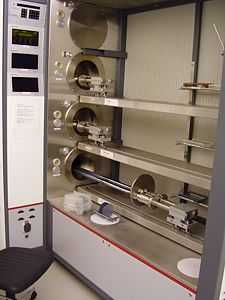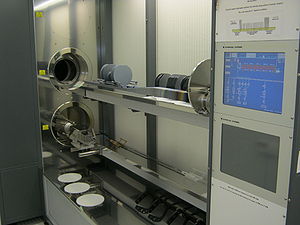Specific Process Knowledge/Thin film deposition/Furnace LPCVD PolySilicon
Feedback to this page: click here
LPCVD (Low Pressure Chemical Vapor Deposition) PolySilicon
Danchip has two furnaces for deposition of LPCVD polysilicon: A new 6" furnace (installed in 2011) for deposition of standard polySi, amorphous polySi and boron doped polySi on 4" or 6" wafers and an older 4" furnace (installed in 1995) for deposition of standard polySi, amorphous polySi, boron- and phosphorous doped polySi on 4" wafers. In LabManager the two furnaces are named "Furnace: LPCVD Poly-Si" and "Furnace: LPCVD Poly-Silicon 6inch", respectively. Both furnaces are Tempress horizontal furnaces.
The LPCVD polysilicon deposition is a batch process, where polySi is deposited on a batch of 25 or 50 wafers (6" polySi furnace) or 30 wafers (4" polySi furnace). The polySi has a good step coverage, and especially for standard polySi the film thickness is very uniform over the wafers.
The reactive gas is silane (SiH4). The dopant for boron doped polySi is BCl3 (6" polySi furnace) or B2H6 (4" polySi furnace), and for phosphorous doped polySi the dopant is PH3. For standard polysilion the deposition takes place at a temperature of 620 oC and a pressure of 200-250 mTorr. For amorphous polysilicon the deposition temperatures and thus the deposition rate are lower, and for boron and phosphorous doped polySi the deposition temperature is 600 oC - 620 oC depending on whether you use the 6" or the 4" polySi furnace. For phousphorous doped polySi the deposition rate is approximately ten times lower than for boron doped polySi. More process information about the process parameters can be found in the table below.
The user manual(s), quality control procedure(s) and results, technical information and contact information can be found in LabManager:
4" LPCVD polysilicon furnace (B4)
6" LPCVD polysilicon furnace (E2)
Process information
Please take a look at the process side for deposition of polysilicon using LPCVD:
Deposition of polysilicon using LPCVD
| Equipment | 4" LPCVD polysilicon furnace (B3) | 6" LPCVD polysilicon furnace (E2) | ||
|---|---|---|---|---|
| Purpose | Deposition of |
|
4" furnace:
| |
| Performance | Step coverage |
|
| |
| Film quality |
|
| ||
| Process parameter range | Process Temperature |
|
The process temperature vary over the furnace tube | |
| Process pressure |
|
The process pressure depends on the actual process | ||
| Gas flows |
The silane (SiH4) flow depends on the actual process |
| ||
| Substrates | Batch size |
Including a testwafer with ~110 nm oxide |
Including a testwafer with ~110 nm oxide |
|
| Substrate materials allowed |
|
| ||

